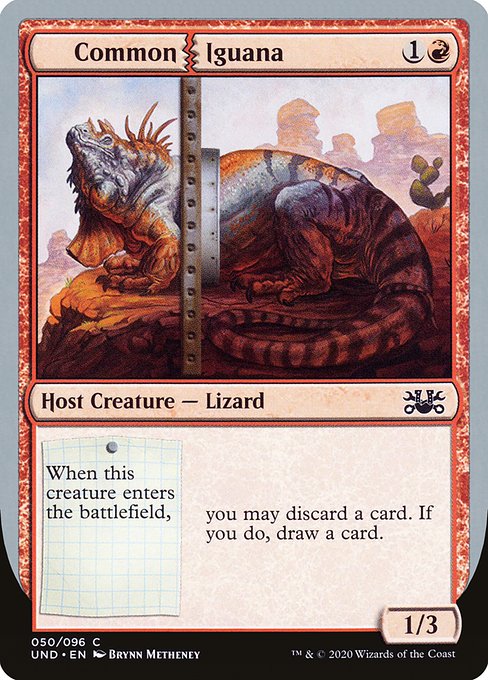
Image courtesy of Scryfall.com
Vector Magic: Using Embeddings to Group Cards by Similarity
In the growing world of MTG data science, every card becomes a data point. By turning mana costs, card types, and even the lore-filled text into a vector, we can visualize a map of the game where cards that feel alike cluster together. This is the essence of embeddings in practice: turning qualitative flavor into quantitative proximity. When fans talk about discovering hidden synergies or remixing theme decks, they’re really talking about navigating a vector space that encodes strategy, flavor, and collectability all at once 🧙♂️🔥.
Consider Common Iguana, a compact red creature from Unsanctioned. With a cost of {1}{R}, a modest 1/3 stat line, and an ETB ability that invites you to discard a card to draw one, it anchors a precise cluster: red cards that reward hand-shaping and card replacement. In an embedding, its color identity and CMC pull it toward other red tempo and card-draw effects, while its unique flavor—host creature, lizard-ish mischief, and a silver-border set—nudges it into a playful sub-cluster that distinguishes casual, unsanctioned play from serious tournament lines. The card’s place in Unsanctioned adds a layer of humor and novelty to its vector, which is exactly the kind of nuance an encoder loves to capture. Brynn Metheney’s art, with its bright, whimsical vibe, adds a visual signature that can also influence clustering in image-rich representations 🧠💎.
From a design perspective, Common Iguana sits at an interesting intersection of speed, card selection, and risk. For a deck that thrives on tempo, the ETB draw after discarding a card creates a small but meaningful exchange: you trade one resource for another, smoothing your draws as the game unfolds. That kind of interaction—an exchange between hand and deck—becomes a signal in an embedding model: “ETB draw with a discard cost” tends to cluster with other red cards that leverage hand-state changes for advantage. It’s a micro-engine in a color that’s all about `go fast or go home` energy, and the model learns to see that rhythm across sets, frames, and print runs 🧪⚡.
But embeddings aren’t just about gameplay mechanics. They’re also about context and culture. Unsanctioned’s tongue-in-cheek flavor, the silver border, and the playful, non-foil presentation contribute to a distinct cluster of cards that are prized not for meta viability but for personality and collecting fun. When you map card data across metadata like set type, rarity, and artwork, you’ll notice a lively arc: mainstream sets cluster toward efficiency and power, while offbeat sets cluster toward experimentation and humor. Common Iguana is a perfect mascot for that cross-section—a red, affordable, rules-bending piece that embodies both strategy and smile-worthy moments. 🎨🗺️
Practically speaking, how do we turn this into actionable insight? A typical embedding pipeline might start with a feature set that includes:
- Mana cost (CMC) and color identity
- Card type and subtypes
- Rarity and set information
- Keywords and the exact text of the ETB or activated abilities
- Power/Toughness and any special rules
- Art style or border characteristics (if you’re combining text and image data)
From there, you can train a model to produce vector representations, then apply clustering (k-means, DBSCAN, or hierarchical methods) or dimensionality reduction (t-SNE, UMAP) for visualization. In practice, Common Iguana’s vector would sit near cards that reward hand manipulation in red, alongside other two-mana or three-mana red creatures with lively ETB interactions. Its placement helps players and collectors alike discover nearby candidates for casual build-around concepts or for fun, on-theme deck ideas. And yes, a simple desk setup—like a Gaming Mouse Pad 9x7 Neoprene with Stitched Edges—can make your study space feel right for mapping out this delightful, vector-driven MTG universe 🧲🎲.
As you imagine the pathway from card data to a cohesive clustering map, remember that good embeddings balance both utility and flavor. The “Common Iguana” node is a reminder that even small creatures with modest stats can punch above their weight in a vector space when their rules interactions and aesthetic flavor are properly captured. When you combine thoughtful feature choices with clean data sources—Scryfall’s reliable card data, for example—you unlock a world where discovering synergy is less about flipping pages and more about exploring a dynamic, living map of cards. And that’s where the magic truly lives 🧙♂️💎.
Why this matters for players and collectors
For players, embeddings illuminate paths to hidden synergies—like ETB draw-after-discard combos that you might overlook when skimming card text. For collectors, clustering by set, frame, and popularity helps reveal printing histories, reprint dynamics, and price correlations across the MTG ecosystem. Common Iguana’s niche—availability as a common nonfoil from a humorous set—underscores how even noncompetitive players can find meaningful value in analyzing card data and artwork. The result is a richer, more intuitive way to navigate MTG’s vast landscape, where strategy, whimsy, and artistry coexist in a single deck-building conversation 🧙♂️🎨.
Gaming Mouse Pad 9x7 Neoprene with Stitched EdgesMore from our network
- https://crypto-acolytes.xyz/blog/post/half-of-uk-adults-now-use-mobile-payments/
- https://transparent-paper.shop/blog/post/top-file-formats-for-selling-digital-products/
- https://crypto-acolytes.xyz/blog/post/when-pixels-tie-the-knot-in-game-marriages-and-virtual-relationships/
- https://blog.digital-vault.xyz/blog/post/skullspore-nexus-lore-decoding-its-fungus-filled-name/
- https://transparent-paper.shop/blog/post/choosing-color-palettes-for-digital-paper-that-pop/